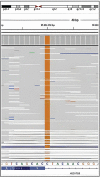46,XY Sex Development Defect due to a Novel Homozygous (Splice Site) c.673_1G>C Variation in the HSD17B3 Gene: Case Report
- PMID: 33389920
- PMCID: PMC9176087
- DOI: 10.4274/jcrpe.galenos.2020.2020.0249
46,XY Sex Development Defect due to a Novel Homozygous (Splice Site) c.673_1G>C Variation in the HSD17B3 Gene: Case Report
Abstract
The enzyme 17-β-hydroxysteroid dehydrogenase type 3 (17β-HSD3) catalyzes the biosynthesis of testosterone (T) from Δ4-androstenedione, and plays an important role in the final steps of androgen synthesis. 17β-HSD3 deficiency originates from mutations in the HSD17B gene, causing an autosomal recessive 46,XY sex developmental disorder (DSD). Patients with 46,XY karyotype can exhibit a wide phenotypic spectrum, varying from complete external female genitalia to male genitalia with hypospadias. Here we report a case of 17β-HSD3 deficiency diagnosed in the infantile period who was later found to have a novel HSD17B3 gene variation. The 14-month old patient, who exhibited a female phenotype, presented with a bilateral lump in the inguinal area. Imaging revealed bilateral testicular gonads in the inguinal area. Hormonal evaluation showed low levels of basal and stimulated serum T, a high level of androstenedione (A), and a low T/A ratio. Chromosomal analysis showed 46,XY karyotype. Sequence analysis of the HSD17B3 gene revealed a c.673_1G>C homozygous class 2 (splice site) variation in intron 9. The consanguineous parents were sequenced, and both were heterozygous for the same mutation. This variation has not been previously reported in the literature. In conclusion, a 46,XY DSD should be considered in patients with a female phenotype who exhibit gonad(s) in the inguinal area at an early age. Furthermore, in patients with insufficient T synthesis and high levels of androstenedione, 17β-HSD3 should be considered, and molecular analysis should be done for a definitive diagnosis and subsequent genetic counseling.
Keywords: 46,XY disorders of sex development; beta-hydroxysteroid dehydrogenase type 3; HSD17B3 gene.
Figures
Similar articles
-
A novel missense mutation in HSD17B3 gene in a 46, XY adolescent presenting with primary amenorrhea and virilization at puberty.Clin Chim Acta. 2015 Jan 1;438:154-6. doi: 10.1016/j.cca.2014.07.025. Epub 2014 Jul 24. Clin Chim Acta. 2015. PMID: 25064799
-
Molecular mechanisms underlying the defects of two novel mutations in the HSD17B3 gene found in the Tunisian population.J Steroid Biochem Mol Biol. 2023 Mar;227:106235. doi: 10.1016/j.jsbmb.2022.106235. Epub 2022 Dec 20. J Steroid Biochem Mol Biol. 2023. PMID: 36563763
-
Novel mutations of HSD17B3 in three Chinese patients with 46,XY Disorders of Sex Development.Steroids. 2017 Oct;126:1-6. doi: 10.1016/j.steroids.2017.07.009. Epub 2017 Aug 1. Steroids. 2017. PMID: 28774765
-
46,XY disorder of sex development (DSD) due to 17β-hydroxysteroid dehydrogenase type 3 deficiency.J Steroid Biochem Mol Biol. 2017 Jan;165(Pt A):79-85. doi: 10.1016/j.jsbmb.2016.05.002. Epub 2016 May 6. J Steroid Biochem Mol Biol. 2017. PMID: 27163392 Review.
-
17β-Hydroxysteroid dehydrogenase 3 deficiency: Three case reports and a systematic review.J Steroid Biochem Mol Biol. 2017 Nov;174:141-145. doi: 10.1016/j.jsbmb.2017.08.012. Epub 2017 Aug 25. J Steroid Biochem Mol Biol. 2017. PMID: 28847746
Cited by
-
Disorder of Sex Development Due to 17-Beta-Hydroxysteroid Dehydrogenase Type 3 Deficiency: A Case Report and Review of 70 Different HSD17B3 Mutations Reported in 239 Patients.Int J Mol Sci. 2022 Sep 2;23(17):10026. doi: 10.3390/ijms231710026. Int J Mol Sci. 2022. PMID: 36077423 Free PMC article. Review.
-
Genomic technologies and the diagnosis of 46, XY differences of sex development.Andrology. 2025 Jul;13(5):1025-1043. doi: 10.1111/andr.13708. Epub 2024 Jul 31. Andrology. 2025. PMID: 39081229 Free PMC article. Review.
-
Current perspectives in hypospadias research: A scoping review of articles published in 2021 (Review).Exp Ther Med. 2023 Mar 23;25(5):211. doi: 10.3892/etm.2023.11910. eCollection 2023 May. Exp Ther Med. 2023. PMID: 37090085 Free PMC article.
References
-
- Moeller G, Adamski J. Integrated view on 17beta-hydroxysteroid dehydrogenases. Mol Cell Endocrinol. 2009;301:7–19. - PubMed
-
- Saez JM, De Peretti E, Morera AM, David M, Bertrand J. Familial male pseudohermaphroditism with gynecomastia due to a testicular 17-ketosteroid reductase defect. Studies in vivo. J Clin Endocrinol Metab. 1971;32:604–610. - PubMed
-
- Saez JM, Morera AM, De Peretti E, Bertrand J. Further in vivo studies in male pseudohermaphroditism with gynecomastia due to a testicular 17-ketosteroid reductase defect (compared to a case of testicular feminization) J Clin Endocrinol Metab. 1972;34:598–600. - PubMed
-
- Boehmer AL, Brinkmann AO, Sandkuijl LA, Halley DJ, Niermeijer MF, Andersson S, de Jong FH, Kayserili H, de Vroede MA, Otten BJ, Rouwé CW, Mendonça BB, Rodrigues C, Bode HH, de Ruiter PE, Delemarre-van de Waal HA, Drop SL. 17β-hydroxysteroid dehydrogenase-3 deficiency: diagnosis, phenotypic variability, population genetics and world wide distribution of ancient and de novo mutations. J Clin Endocrinol Metab. 1999;84:4713–4721. - PubMed
-
- Rösler A, Silverstein S, Abeliovich D. A (R80Q) mutation in 17 betahydroxysteroid dehydrogenase type 3 gene among Arabs of Israel is associated with pseudohermaphroditism in males and normal asymptomatic females. J Clin Endocrinol Metab. 1996;81:1827–1831. - PubMed
Publication types
MeSH terms
Substances
LinkOut - more resources
Full Text Sources

